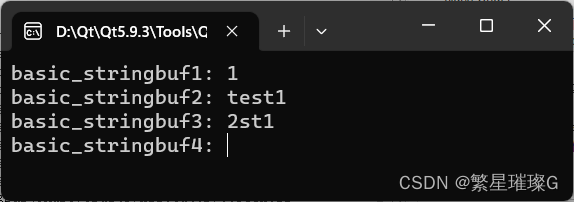定义于头文件 <sstream>
| template< class CharT, |
std::basic_stringbuf 是关联字符序列为内存常驻的任意字符序列的 std::basic_streambuf 。能从 std::basic_string 的实例初始化它,或将它做成该类的实例。
std::basic_stringbuf 的典型实现保有一个 std::basic_string 类型对象,或等价的可伸缩序列容器作为数据成员,并将它同时用作受控制字符序列(为 std::basic_streambuf 的六个指针所指向的数组)和关联字符序列(所有输入操作的字符源和输出操作的目标)。
另外,典型的实现保有一个 std::ios_base::openmode 类型的数据成员,以指示流的状态(只读、只写、读写、尾端写等)。
| 若 overflow() 使用过分配策略,则可存储另外的高水位指针,以跟踪最后初始化的字符。 | (C++11 起) |
亦提供二个对常用字符类型的特化:
| 类型 | 定义 |
stringbuf | basic_stringbuf<char> |
wstringbuf | basic_stringbuf<wchar_t> |
公开成员函数
构造一个 basic_stringbuf 对象
std::basic_stringbuf<CharT,Traits,Allocator>::basic_stringbuf| basic_stringbuf() : basic_stringbuf(std::ios_base::in | std::ios_base::out) { } | (1) | |
| explicit basic_stringbuf( std::ios_base::openmode which = std::ios_base::in | std::ios_base::out ); | (2) | (C++11 前) |
| explicit basic_stringbuf( std::ios_base::openmode which ); | (C++11 起) | |
| explicit basic_stringbuf( const std::basic_string<CharT, traits, Allocator>& new_str, std::ios_base::openmode which = std::ios_base::in| std::ios_base::out ); | (3) | |
| basic_stringbuf( const basic_stringbuf& rhs ) = delete; | (4) | (C++11 起) |
| basic_stringbuf( basic_stringbuf&& rhs ); | (5) | (C++11 起) |
1) 默认构造函数。是否初始化序列指针 (eback() 、 gptr() 、 egptr() 、 pbase() 、 pptr() 、 epptr()) 为空指针是实现定义的。
2) 构造 std::basic_stringbuf 对象:通过调用 std::basic_streambuf 的默认构造函数初始化基类,以空字符串初始化字符序列,并设置模式为 which 。
3) 通过进行同 1) 中的的操作构造 std::basic_stringbuf 对象,随后如同通过调用 str(new_str) 初始化关联字符序列。
4) 复制构造函数被删除; std::basic_stringbuf 非可复制构造 (CopyConstructible) 。
5) 通过从另一 std::basic_stringbuf 对象 rhs 移动所有状态,包含关联 string 、打开模式、 locale 和所有其他状态,移动构造 std::basic_stringbuf 对象。移动后,保证 *this 中 std::basic_streambuf 的六个指针异于被移动的 rhs 中的指针,除非它们为空。
参数
| new_str | - | 用于初始化缓冲区的 basic_string | ||||||||||||||
| rhs | - | 另一 basic_stringbuf | ||||||||||||||
| which | - | 指定流打开模式。它是位掩码类型,定义下列常量:
|
注意
常由 std::basic_stringstream 的构造函数调用。
异于 std::ios_base::in 和 std::ios_base::out 的打开模式支持级别在实现中各异。 C++11 显式指定 str() 中和此构造函数中支持 std::ios_base::ate ,但 std::ios_base::app 、 std::ios_base::trunc 和 std::ios_base::binary 在不同实现上有不同效果。
调用示例
#include <iostream>
#include <sstream>
int main()
{
// 默认构造函数( mode = in|out )
std::basic_stringbuf<char> basic_stringbuf1;
basic_stringbuf1.sputc('1');
std::cout << "basic_stringbuf1: " << &basic_stringbuf1 << std::endl;
// 在尾端模式中的 string 构造函数 (C++11)
std::basic_stringbuf<char> basic_stringbuf2("test", std::ios_base::in
| std::ios_base::out
| std::ios_base::ate);
basic_stringbuf2.sputc('1');
std::cout << "basic_stringbuf2: " << &basic_stringbuf2 << std::endl;
// 后附模式测试(结果在编译器间有别)
std::basic_stringbuf<char> basic_stringbuf3("test", std::ios_base::in
| std::ios_base::out
| std::ios_base::app);
basic_stringbuf3.sputc('1');
basic_stringbuf3.pubseekpos(1);
basic_stringbuf3.sputc('2');
std::cout << "basic_stringbuf3: " << &basic_stringbuf3 << std::endl;
//5) 通过从另一 std::basic_basic_stringbuf 对象 rhs 移动所有状态,
//包含关联 string 、打开模式、 locale 和所有其他状态,
//移动构造 std::basic_basic_stringbuf 对象。
std::basic_stringbuf<char> basic_stringbuf4(std::move(basic_stringbuf2));
std::cout << "basic_stringbuf4: " << &basic_stringbuf4 << std::endl;
return 0;
}输出

析构函数
析构 basic_stringbuf 对象和其所保有的 string






















 2695
2695











 被折叠的 条评论
为什么被折叠?
被折叠的 条评论
为什么被折叠?








